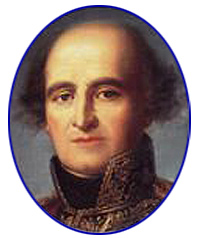

Click to see full text of the Chapter victor_ivanov@ukr.net
Argument of the Chapter
Marshal Jean-Mathieu Philiber Serurier
Early years. Conscription to the military service. Service in the infantry battalion of Laon militia. Ensign of Aumont infantry regiment. Participation in the Seven-years war. Hanover Campaign of 1759-1760. Heavy wound in the battle at Warburg. Portugal. Campaigns in Spain and on Corsica. Delayed career. Character traits. A projection of Barras in Revolutionary army. Serurier as the chief of Tournoux army camp. Service in the garrison of Nice.
Campaign of 1793. Operational plans of Army commander Brunnet. Attacks on Piedmontians Army camps Rauss and Millefourches. The battle for the pass Tende. Storm of the Lation heights. Grade of the brigadier general. New Army commander Dumerbion. Arrest of Serurier by suspicion in betrayal.
Campaign of 1794. Second campaign of 1795 in the Alps and Northern Italy. Operational and offensive plans of the sides. The battle for the Cerisotes emplacement. French offensive for restoration of communications with Genoa. The battle at Borghetto. The battle at Loano. Development of the success at Cheva. Grade of divisional general.
The Italian campaign of 1796. State of the French army. Ąustrian-Piedmont Army. Operational formation. Impact upon the Piedmont Army. Seruriers role is pinning-up. Unsuccessful frontal attack. Tactical novelties during the battle at Ģīndovi. Taking Piedmont out of war. Maneuver against Beaulieu on the river Poe. Distracting maneuvers of Serurier and Ģąssena. Occupation of Lodi and Cremona. Offensive against Beaulieu. The description of the first siege of the Ģąntua fortress. Siege actions under command of Serurier. Refusal from intentions to storm the fortress. Removal of siege. The first offensive of Wurmser. Serurier hands over command to the general Fiorelli because of illness and leaves for France. Victory at Castiglione without Serurier. The second siege of the Mantua fortress. Unsuccessful Austrians attempts to deblock Mantua. Capitulation of Wurmser.
The operational plan for the campaign of 1797. The battle at Ņągliamento river. Pursue of the receding Austrians. A new attack of illness and leave. Honourable mission to Paris. Serurier as a staunch defender of the Republic. Analysis of the Italian campaign of Serurier. Serurier as the military governor of Venice.
Serurier as the division commander in the Italian army of Sherer in campaign of 1799. Operational plans and position of the sides. The plan to attack the Austrian right flank between Verone and lake Garda. Seruriers division is on the edge of attack. The Austrians overturn in the valley of Adidge river. Failure at the bridge Polo. A regrouping of forces of the Italian army. Arrival of Suvorows Russian grouping. Plans of allied command. Plans of the French command. Counter fights. Offensive of Seruriers division on Villafranca. Defeat on the Adda river. Deviation of Scherers army. The battle for bridgehead Lekko. Break of the French operational line. The battle at Cassano. An environment of Seruriers division in Veredrio. Captivity.
Return to Paris. Support of Brumair revolution. Support of Brumeir revolution. Vacation of military service in 1801. Vice-president of the Senate. Ģąrshal of the Empire. Marshal Serurier as the governor of House of Invalids. Marshal Serurier national Guard commander in 1809. Transition to the party of Bourbons. One Hundred Days. Resignation. Death. Analysis of military leaders career of marshal Serurier.
Maps of the Chapter Marshal Jean-Mathieu Philiber Serurier"
1. Situation at Lake Garda (July 24 August 8, 1796).
2. The first siege of Mantua.
3. Maneuver at Castiglione.
Illustrations of the Chapter Marshal Jean-Mathieu Philiber Serurier
1. Serurier the soldier of Kings army.
2. The French Republican armys uniforms:
Grenadier of National Guard;
Chasseur;
Hussar-volunteer.
3. The Austrian infantrymans uniform of general Argenteaus force.
4. The French Republican armys uniforms:
Repulican general and soldier of a personal escort;
Officer of light infantry.
5. Portrait of general Dommartin.
6. Portrait of general Kilmane.
7. Portrait of general Chasseloup.
8. Portrait of Field-Marshal Wurmser.
9. Portrait of Archduke Charles.
10. The Austrian infantrymans uniform of general Jordiss force.
11. Battle at river Adda.
12. Hotel of Invalides.
13. The Arms of Serurier.
14. Portrait of marshal Serurier.
15. Marshal Seruriers grave.
The structure of military-historical monograph
«Military campaigns of Napoleons marshals»
Preface.
Introduction.
Chapter 1 marshal Jean Baptiste Jules Bernadotte, Prince of Ponte Corvo (1763-1844).
Chapter 2 marshal Louis Alexander Berthier, Prince of Neuchatel, Prince of Walange, Prince of Wagram (1753 1815).
Chapter 3 marshal Jean Baptiste Bessieres, Duke of Istria (1768-1813).
Chapter 4 marshal Guillaume-Marie-Anne Brune (1763-1815).
Chapter 5 marshal Victor Claude Victor-Perrin, Duke of Belluno (1764 1841).
Chapter 6 marshal Laurent Gouvion Saint-Cyr, marquess (1764-1830).
Chapter 7 ģąšųąė Emmanuel Robert de Grouchy, marquess (1766-1847).
Chapter 8 marshal Louis Nicolas Davout, Duke of Auerstaedt, Prince of Eckmuhl (1770-1823).
Chapter 9 marshal Jean Baptiste Jourdan, count (1762-1833).
Chapter 10 marshal Francois Etienne Christophe Kellermann, Duke de Valmy (1735-1820).
Chapter 11 marshal Jean Lannes, Duke of Montebello (1769-1809).
Chapter 12 marshal Francois Joseph Lefebvre, Duke of Danzig (1755-1820).
Chapter 13 marshal Jacques-Etienne-Joseph-Alexander Macdonald, Duke of Tarente (1765-1840).
Chapter 14 marshal Auguste Frederic Louis de Viesse Marmont, Duke of Ragusa (1774-1852).
Chapter 15 marshal Andre Massena, Duke of Rivoli, Prince of Essling (1758-1817).
Chapter 16 marshal Bon Adrien Jeannot Moncey, Duke of Conegliano (1754-1842).
Chapter 17 marshal Adolphe Edouard Casimir Joseph Mortier, Duke of Treviso (1768-1835).
Chapter 18 marshal Joachim Murat, King of Naples (1767-1815).
Chapter 19 marshal Michel Ney, Duke of Elchingen, Prince of Moskwa (1769-1815).
Chapter 20 marshal Pierre Francois Charles Augerau, Duke of Castiglione (1757-1816)
Chapter 21 marshal Dominique-Catherine Perignon, marquis de Grenade (1754-1818).
Chapter 22 marshal Joseph Antoine Ponyatovsky, prince of Poland (1763-1813).
Chapter 23 marshal Jean-Mathieu Philiber Serurier (1742-1819).
Chapter 24 marshal Nicolas Jean de Dieu Soult, Duke af Dalmatia (1769-1851).
Chapter 25 marshal Louis Gabriel Suchet, Duke of Albufera (1770-1826).
Chapter 26 marshal Nicolas-Charles Oudinot, Duke of Reggio (1767-1847).
Conclusions.
Literature.